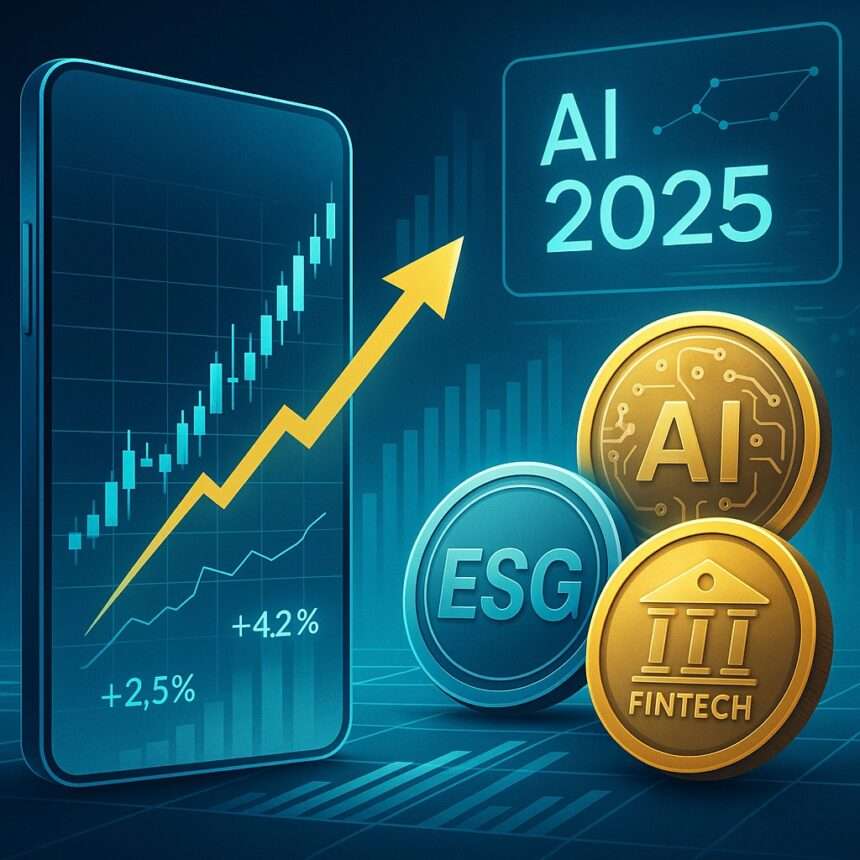2025 financial trends are reshaping how individuals, corporations, and governments approach money. This year is not just another chapter in the economic cycle—it’s a decisive period where policy shifts, technological breakthroughs, and global collaboration are converging. Whether you’re an investor, entrepreneur, policymaker, or simply someone looking to protect and grow your wealth, understanding these trends is crucial to making informed financial decisions.
Interest Rates and the Bigger Picture in 2025 Financial Trends
One of the most closely watched factors in the global economy remains central bank policy. In the United States, the Federal Reserve has adopted a cautious stance, maintaining higher interest rates to curb inflation while avoiding a complete economic slowdown. In contrast, the European Central Bank is signaling potential rate cuts to stimulate growth, particularly in regions where consumer spending remains weak.
These moves are more than just numbers on a chart—they directly influence mortgage rates, business loans, and investment yields. For instance, small businesses in emerging markets may find access to credit easier in 2025 due to looser monetary policies, while U.S. borrowers may continue to face higher borrowing costs. Investors must consider how these dynamics affect different asset classes, from real estate to fixed-income securities.
Sustainable Investing in 2025 Financial Trends
Sustainability has moved from a niche interest to a mainstream requirement. ESG (Environmental, Social, and Governance) investments are now a critical part of institutional and retail portfolios. However, there’s growing scrutiny over “greenwashing”—false or exaggerated claims about a company’s environmental impact. Governments and regulators are tightening disclosure rules, requiring businesses to back sustainability claims with verifiable data.
For example, the EU’s Sustainable Finance Disclosure Regulation (SFDR) now compels fund managers to provide transparent reporting on how investments meet ESG criteria. This has encouraged more companies to adopt renewable energy sources, improve labor practices, and commit to carbon neutrality. Investors who align with genuinely sustainable firms are not only supporting ethical business practices but also positioning themselves for long-term gains as consumer preferences shift toward responsible brands.
Technology’s Role in Shaping 2025 Financial Trends
Technology continues to be a major disruptor in the financial sector. Artificial intelligence is enhancing everything from credit scoring to fraud detection. Fintech startups are creating mobile-first banking solutions for underserved populations, while blockchain is facilitating near-instant cross-border transactions with reduced fees.
One notable trend in 2025 is the rise of “embedded finance,” where financial services are integrated directly into non-financial platforms. This means you might secure a loan while booking a holiday online or invest in a stock directly from a social media app. These innovations expand accessibility, but they also bring new regulatory challenges and cybersecurity risks that must be addressed. For more insights into the tech shift, check World Economic Forum’s financial innovation hub.
Global Trade and Geopolitical Influence
Geopolitics play an increasingly significant role in shaping 2025 financial trends. Trade agreements between economic powerhouses are reshaping supply chains. The ongoing shift toward diversified sourcing—spurred by past disruptions—has opened opportunities for countries in Southeast Asia, Africa, and Latin America to become new manufacturing hubs.
At the same time, conflict resolution in certain regions has bolstered investor confidence, while instability in others continues to pose risks. Understanding these geopolitical currents is essential for businesses deciding where to expand and for investors weighing the balance between growth potential and political risk. You can track real-time developments through the IMF’s economic reports.
Changing Consumer Spending and Investment Behavior
Consumer behavior in 2025 reflects a more conscious and digitally savvy population. People are not just looking for the cheapest option—they want products and services that align with their values, whether that’s sustainability, inclusivity, or innovation. In the investment space, retail participation has surged, aided by low-cost online brokerages and the ability to trade fractional shares.
Social media trends can now move markets in hours rather than days, as seen in the “meme stock” phenomenon of past years. While this offers opportunities for quick gains, it also introduces volatility that requires a disciplined approach to risk management.
Risk Management Strategies in 2025 Financial Trends
Given the volatility of the modern economy, robust risk management is no longer optional—it’s a necessity. Investors are diversifying not just across asset classes, but also across geographic regions and industries. Many are adding alternative investments like commodities, private equity, and real estate to balance traditional portfolios.
On the corporate side, companies are investing heavily in predictive analytics and scenario planning to anticipate market disruptions. Retail investors are increasingly adopting hedging strategies, such as using options to protect stock positions or investing in gold as a safe-haven asset.
Opportunities in Emerging Markets
Emerging markets remain one of the most promising areas in 2025 financial trends. Rapid urbanization, expanding middle classes, and increased internet access are driving strong economic growth in regions like Sub-Saharan Africa, Southeast Asia, and parts of Latin America.
Infrastructure projects, renewable energy investments, and fintech innovations are at the forefront. For example, mobile payment platforms in Africa are enabling millions of people to access banking services for the first time, unlocking both consumer demand and business growth opportunities. The World Bank’s financial sector reports provide valuable data for investors interested in these regions.
The Interplay Between ESG, Technology, and Policy
The convergence of ESG priorities, rapid technological innovation, and evolving policy frameworks is defining the future of finance. Governments are introducing incentives for green innovation, while technology companies are creating solutions to track and verify environmental impact in real time.
This synergy is influencing capital flows, corporate strategies, and even consumer purchasing habits. Businesses that can navigate this interconnected environment effectively will not only survive but thrive in the coming years.
Expert Insights on 2025 Financial Trends
Financial analysts agree that adaptability is the most valuable asset in 2025. As one industry expert put it: “Markets no longer move in predictable cycles—they respond to an increasingly complex web of economic, technological, and geopolitical factors.” This means staying informed and being willing to adjust strategies quickly is essential.
Historical data suggests that those who invest consistently through market ups and downs tend to outperform those who attempt to time the market perfectly. In 2025, patience combined with a forward-looking approach could be the winning formula.
Actionable Takeaways for Investors and Businesses
For investors: diversify globally, explore alternative assets, and stay updated on both macroeconomic and sector-specific trends. For businesses: invest in digital transformation, align with ESG standards, and monitor geopolitical developments that could impact supply chains or market demand.
Above all, remain adaptable. The pace of change in 2025 financial trends means that flexibility and strategic foresight are as important as capital itself.
Final Thoughts
Navigating the complexities of 2025 financial trends requires a balance of awareness, adaptability, and action. The interplay of interest rates, sustainability, technology, and geopolitics will shape not just this year, but the years to come. Those who understand and respond effectively to these trends will be best positioned for long-term success.
For more insights into related topics, explore our guide to Global Economic Trends in 2025 and learn how macroeconomic forces are influencing investment decisions worldwide.




